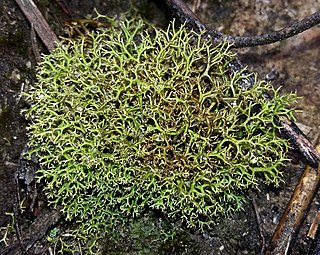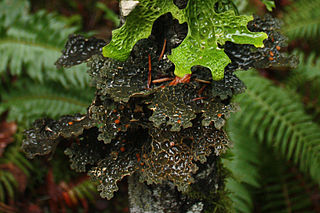
Cladia is a genus of lichenized fungi in the family Cladoniaceae. Cladia species have a crustose primary thallus and a fruticose, secondary thallus, often referred to as pseudopodetium. The type species of the genus, Cladia aggregata, is widely distributed, occurring from South America, South Africa, Australasia and South-East Asia to southern Japan and India. Most of the other species are found in the Southern Hemisphere.

Pseudocyphellaria is a genus of large, leafy lichens that are sometimes referred to as "specklebelly" lichens. The genus has a widespread distribution, especially in south temperate regions, and contains about 170 species. They resemble Lobaria, except that most species of Pseudocyphellaria have conspicuous pseudocyphellae on their lower surface, a characteristic that was once considered unique to this genus. Some species contain pulvinic acid-related pigments; in these species the soredia and pseudocyphellae can be bright yellow.
Menegazzia confusa is a species of foliose lichen found in Australia. It was formally described as a new species in 1987 by lichenologist Peter James. The type specimen was collected by Gintaras Kantvilas near Lake Leake Road in Tasmania, where it was found growing on the bark of Exocarpos cupressiformis in a sclerophyll forest. It also occurs in Victoria. The lichen is quite similar to Menegazzia platytrema, but typically has more crowded apothecia, and lobes that are shorter and more congested. Menegazzia confusa contains caperatic acid as its primary lichen product, whereas M. platytrema contains stictic acid and related compounds.
Menegazzia inactiva is a species of foliose lichen found in New Zealand and Australia. The type locality of this species is in Tasmania, south of Arthur River near Sumac Road. The species was discovered on Tasmannia lanceolata in rainforest habitat. The type specimen is held at the herbarium of the Tasmanian Museum and Art Gallery.
Menegazzia minuta is a rare species of foliose lichen that is endemic to Tasmania, Australia. It was scientifically described as a new species in 1987 by lichenologists Peter James and Gintaras Kantvilas. The type specimen was collected by the second author south of Arthur River, where the lichen was found in a rainforest growing on twigs of leatherwood. The species epithet minuta refers to the small size of its thallus. Menegazzia minuta contains protolichesterinic acid, a lichen product that helps to distinguish it from the similar species Menegazzia eperforata, which instead contains stictic acid and related compounds. In a 2012 publication, Kantvilas called M. minuta "one of Tasmania's rarest lichens", characterised by a "glossy olive-brown thallus of minute, spidery lobes, densely beset with lobule-like isidia".
Menegazzia subbullata is a species of foliose lichen found in Australia and southern South America. It was formally described as a species new to science in 1987 by lichenologists Peter James and Gintaras Kantvilas. The type specimen was collected in Tasmania, where it was found in a coniferous heath growing on Mount Mawson pine. It has also been found in mainland Australia. Its first report outside of Australasia was in 2002, when it was recorded in Patagonia, Argentina. The lichen has been found to grow both on bark and on rocks.
Gintaras Kantvilas is an Australian lichenologist, who earned his Ph.D in 1985 from the University of Tasmania with a thesis entitled Studies on Tasmanian rainforest lichens. He has authored over 432 species names, and 167 genera in the field of mycology.
Punctelia transtasmanica is a species of foliose lichen in the family Parmeliaceae. It is found in Australasia.
Punctelia pseudocoralloidea is a species of foliose lichen in the family Parmeliaceae. It is found in Australia, where it grows on bark and on wood.
Menegazzia athrotaxidis is a species of foliose lichen in the family Parmeliaceae. Found in Australia, the species was described as new to science by Australian lichenologist Gintaras Kantvilas in 2012. The type specimen was collected in Mount Field National Park, southeast of Lake Emmett. Here it was found at an altitude of 980 m (3,220 ft), where it was growing on the bark of pencil pine in a mountainous rainforest. The specific epithet refers to the genus of its host. The lichen is only known to occur in the highlands of Tasmania, where it mostly grows on conifers.
Menegazzia hypogymnioides is a species of foliose lichen in the family Parmeliaceae. Found in Australia, the species was described as new to science by Australian lichenologist Gintaras Kantvilas in 2012. The type specimen was collected from Clear Hill, Tasmania, at an altitude of 1,190 m (3,900 ft), where it was growing on conglomerate boulders in alpine heath. The specific epithet refers to its similarity to a small species of Hypogymnia. It is a very rare species that occurs only at high elevations in southwestern Tasmania, typically in sheltered habitats.
Menegazzia petraea is a rare species of foliose lichen in the family Parmeliaceae. Found in Australia, the species was described as new to science by Australian lichenologist Gintaras Kantvilas in 2012. The type specimen was collected at the summit of Gog Range, Tasmania at an altitude of 720 m (2,360 ft). Here it was found growing on conglomerate boulders in scrubby heath. The specific epithet petraea not only refers to its saxicolous habitat, but also indirectly hints at the first name of English botanist and lichenologist Peter Wilfred James, who, according to Kantvilas, "has made sigificant contributions to the study of Menegazzia and first noted the unusual chemical composition of this species".
Menegazzia ramulicola is a rare species of foliose lichen in the family Parmeliaceae. Found in Australia, the species was described as new to science by Australian lichenologist Gintaras Kantvilas in 2012. The type specimen was collected in Mount Field National Park (Tasmania) at an altitude of 1,030 m (3,380 ft), where it was growing on the Tasmanian endemic plant narrow leaf orites in a woodland. The specific epithet ramulicola refers to its usual habitat, young twigs.
Menegazzia subtestacea is a species of foliose lichen in the family Parmeliaceae. It is found in Tasmania (Australia), where it grows at high elevations on the twigs and young branches of alpine shrubs.
Menegazzia tarkinea is a rare species of foliose lichen in the family Parmeliaceae. It occurs in North West Tasmania (Australia).
Geoffrey Charles Bratt was an Australian chemist and lichenologist.
Menegazzia gallowayi is a species of lichen in the family Parmeliaceae. Found in New Zealand, it was formally described as a new species in 2012 by Australian lichenologist Gintaras Kantvilas. The type specimen was collected near the Craigieburn stream at an altitude of 1,050 m (3,440 ft). Here it was found growing on a young mountain beech. The specific epithet honours New Zealand lichenologist David John Galloway. According to Kantvilas, his work Flora of New Zealand Lichens has "greatly advanced knowledge of the lichens of the Southern Hemisphere".
Schizotrema is a genus of lichen-forming fungi in the family Graphidaceae. The genus was circumscribed in 2009 by Armin Mangold and H. Thorsten Lumbsch.
Roccellinastrum lagarostrobi is a rare species of byssoid (wispy) lichen in the family Byssolomataceae. Found in Australia, it was formally described as a new species in 1990 by lichenologist Gintaras Kantvilas. The type specimen was collected from Pine Creek, north of Greystone bluff (Tasmania) at an altitude of 140 m (460 ft); here, along the bank of a stream, at the edge of a rainforest, the lichen was found growing as an epiphyte on leafy twigs of the endemic conifer Lagarostrobos franklinii. It has a white, cottony (byssoid) thallus that forms irregularly shaped tufts typically measuring 2–4 mm wide. The lichen produces the chemical protocetraric acid. The species epithet lagarostrobi refers to the genus of the phorophyte. It is only known to occur at a few locations in Tasmania; its diminutive size and somewhat inconspicuous appearance makes it easy to miss.
Cameronia is a genus of crustose lichens in the monotypic family Cameroniaceae. It has two species. Both the genus and its two species were described as new to science in 2011 by Australian lichenologist Gintaras Kantvilas. Characteristics of the genus include its chlorococcalean photobiont partner, and perithecioid ascomata that are deeply immersed in the substrate. Microscopic features of Cameronia include the four-spored asci with an intensely hemiamyloid outer wall and non-amyloid, well-developed tholus, and hyaline, muriform ascospores. Both species are endemic to the Tasmanian Highlands.

